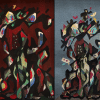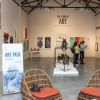Finding time to visit art galleries and exhibitions often feels like a luxury we cannot afford in this city of ours. But what if art finds you on your way to the office, or on morning walks? Yes, there are some artists in Dhaka whose creations are not confined within the walls of a gallery — they breathe in the open. These hidden visionaries and performers have turned our pavements into canvases and street corners into galleries. It's subtle yet subversive, an unassuming revolution in broad daylight! Today, let's dive into their stories.
Scrolls of the streets
The very first person we start with is Nazir Hossain, better known as 'Tiger Nazir.' He is a self-taught potua, or scroll painter. He earned the name by painting tigers in scroll art. You will spot him outside Charukala, near the National Museum in Shahbagh. With brushes in hand and a canvas covered with paint, he, himself, appears to be a live canvas. You may even be fortunate enough to see his fresh paintings hanging from a rope if you happen to go there at the perfect time. Whatever, whenever, speaks to Nazir's spirit; he paints it with a touch of tiger in it.
Nazir's talent gained international recognition in 2015 when his powerful and graceful artwork, Bantora Kun, was chosen as the mascot for Bangladesh-Japan business circles. He first displayed his scroll paintings at ChobirHaat, an open-air art gallery near Dhaka University.
Nazir also contributed to a novel, Tuki the Tiger by Alexis Krasilovsky and Shameem Akhtar, with his colourful and lively illustrations.
Despite his achievements, Hossain remains grounded, always carrying our national flag tied around his forehead. When asked about his inspiration, Nazir Hossain simply states, "It was my mother's nakshi kantha that brought me here. The patterns she stitched, the stories she told with her needle, still inspire my art."
Hossain prefers to paint on the streets, not for lack of opportunity, but for a sense of purpose. "The streets keep me connected to people," he says. "Art isn't just about galleries; it's about reaching those who might never step into one. It's about making them pause, reflect, and feel something."
Melodies in the air
A few steps away from Nazir Hossain, you'll find Md Lal Mea outside Charukala, a bongshibajok (flute maestro) who has been crafting and playing his beloved flutes for nearly 40 years. You will see him playing his flute while waiting for curious passers-by to stop and admire his work.
Seeing him then and there playing his flute, I could not resist striking up a conversation. But before I could finish, he totally cut me off with a surprising question, "Is this the first time you've noticed me here?" And the answer from my side was a simple "Yes," but his response left me speechless — "You've been studying here for more than five years, yet you never noticed me. See? That's the life of a street artist in this country; a few admirers and our passion are all that keep us going."
Lal Mea's words put me in guilt. He made me think of a family I used to see at Rabindra Shorobor — a father and daughter duo singing soulful Bhatiyali songs, drawing a small crowd with their heartfelt performances. But they're no longer there. Perhaps they, too, were casualties of the unrelenting battle for survival on Dhaka streets.
Through the looking glass
There's another dedicated soul — Mohammad Hiru, the bioscope-wala in a clown costume. Although he ditches the costume in summer, you will always spot him with his colourful hat that never fails to draw attention.
Hiru usually sets up after 5 PM near Anam Rangs Plaza at 6/A Satmasjid Road, Dhanmondi, where he showcases his handcrafted bioscope with pride. He sings songs of all kinds when you peer into the tiny holes of his bioscope.
"This bioscope is my dream box," says Hiru bhai, every time I ask him about it. "I have made my own bioscope from scratch, with no master to guide me," he shares. "The first time I saw one at a village fair in Bogra, I just knew I had to create my own. I was a kid back then. But now, here I am, living that dream." Though Hiru Bhai, too, faced his fair share of consequences while following his dream on the streets. Yet his passion keeps him going.
To me, Mohammad Hiru is a living reminder of the beauty and persistence of street art. What fills my heart is seeing him standing as a beacon of resilience against all odds.
Brushstrokes of resilience
Now, let's talk about a part-time street artist, Md Fazar Ali, studying graphic design at the University of Dhaka. He is often seen with his canvas and brushes, capturing the world around him through his strokes. Whether at the Central Shaheed Minar or Kamalapur Railway Station, you will see him creating portraits and sketches.
But there are drawbacks to Fazar's love of art as well. "The lack of interest I encounter from others can be disheartening at times," he says. "I was once insulted by a customer when I brought up the cost of a hand-drawn sketch. According to him, printing a high-resolution photo would be better and less expensive than my sketch."
Fazar's words sheds light on the often-overlooked struggles of artists who put their all into their work, only to face a lack of recognition for the value of their work.
What I realised after talking to all of them is that art isn't really accepted here, let alone appreciated! And when it's on the street, it is seen as something unnecessary, even frivolous.
However, people like Lal Mea, Hiru Bhai, or Tiger Nazir are still there. Being the stubborn gatekeeper of their passion and our culture!
So next time you hear the soft strains of a flute or catch a glimpse of a colourful scroll, stop for a moment. Listen. See. Because behind every note and brushstroke is a story of resilience here.









Comments